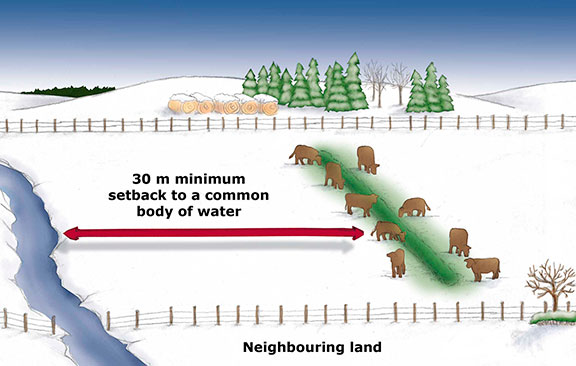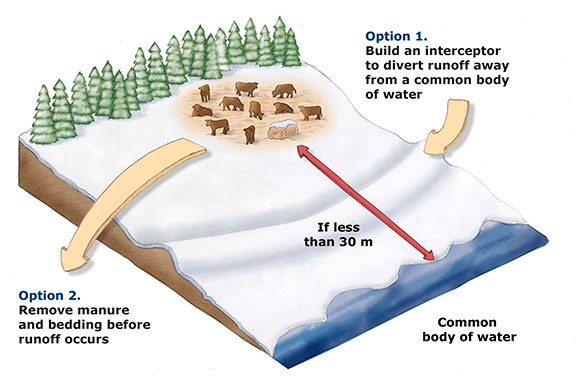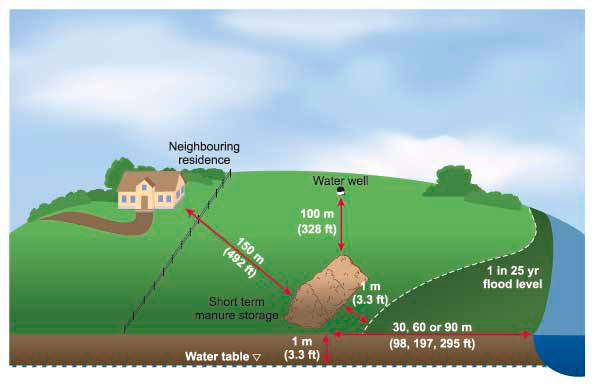| | Managing your manure | Wintering sites and livestock corrals | Manure storage | Manure application | Record keeping and soil testing | Enforcement of AOPA
The purpose of AOPA is to ensure that the province’s livestock industry will grow in an environmentally sustainable manner as it meets the opportunities presented by local and world markets.
Manure management requirements for all Alberta agricultural operations, including horse owners, are outlined in the Standards and Administration Regulation of the Agricultural Operation Practices Act (AOPA). However, new or expanding horse operations which exceed specified animal numbers may also need a permit from the Natural Resources Conservation Board (NRCB).
Do you need a permit?
If your facility existed prior to January 1, 2002, was above threshold numbers and has not expanded or modified any facilities, it is considered to have been deemed a permit, based on the capacity of the operation at the time. No action is necessary by the operator.
However, new and expanding operations that exceed threshold animal numbers and are not an equestrian stable, auction market, race track, or exhibition ground, will need a permit under AOPA. A registration, approval or authorization will be required depending on the proposed development or expansion. A registration or approval permit will depend on your animal numbers whereas those operations improving their long term manure storage may require an authorization. Each permit has different requirements.
| Equine Threshold Animal Numbers |
| Type of Horse Operation | Permit Type |
| Registration | Approval |
| Feeders > 750 lbs | 100-299 | 300+ |
| Foals < 750 lbs | 350-999 | 1000+ |
| Mules | 100-299 | 300+ |
| Donkeys | 150-449 | 500+ |
Managing Your Manure
All horse owners are required to manage manure according to AOPA regulations. These requirements apply to:
- wintering sites (seasonal feeding and bedding sites) and livestock corrals
- manure storage
- manure application
- record keeping and soil testing
Manure includes straw, other bedding material, litter, soil and feed. The rules are the same for composted manure.
Wintering Sites and Livestock Corrals
Wintering sites are referred to as seasonal feeding and bedding sites (SFBS) in AOPA. Seasonal feeding and bedding sites and horse corrals must be located at least 30 metres away from a common body of water (Figure 1).

Figure 1. Wintering site or livestock corral setback distances
If a corral or SFBS is closer than 30 metres, there are two options (Figure 2):
Option 1: Design the site to divert runoff away from the common body of water* (e.g. berm or ditch) or
Option 2: Move manure and bedding to an appropriate manure storage facility or area before runoff occurs.
* A common body of water refers to the bed and shores of rivers, streams, creeks (both permanent and intermittent) and canals as well as reservoirs, lakes, marshes and sloughs that are shared by or common to more than one landowner

Figure 2. Options for sites that do not meet the 30 metre setback distance
Manure Storage
Proper storage of manure is an important aspect of any horse operation. Manure storage sites should be considered as either short term or long term storage.
1. Short term manure storage
Short term manure storage sites allow horse owners to stockpile manure before it is spread on the land. A short term storage site can store manure for a total of seven months within a three year period, regardless of the amount of manure stored.
Location of short term solid manure storage sites must be:
- at least 150 metres from a residence or occupied building that the producer does not own;
- at least one metre above the water table;
- a setback distance to common bodies of water (see table below);
- at least 100 m from a spring or water well; and,
- above the 1 in 25 year flood level.
| Setback distances for short term manure storages |
| Average slope within 90 metres of a common body of water | Setback distance required from the common body of water |
| 4% or less | 30 m |
| 4% to 6% | 60 m |
| 6% to 12% | 90 m |
| Greater than 12% | No storage |

Figure 3. Short term manure storage setbacks
2. Long term manure storage
A manure storage site is considered a long term manure storage if it is used for more than seven months over a three year period. If the storage contains over 500 tonnes of manure it will require an authorization permit from the NRCB.
Long term manure storage facilities need to be constructed to meet the following requirements:
- use run-on and runoff controls to protect surface water;
- be located at least 100 metres from a water well or spring and of water;
- be sited at least 1 metre above the one in 25 year maximum flood level; and,
- have either a naturally occurring protective layer or other liner to protect groundwater.
Manure Application
For more information on manure application please refer to the Agdex 096-8 2012 Manure Spreading Regulations.
Record Keeping and Soil Testing
Manure management records are required by operators who handle 500 tonnes of manure or more in a year. These records must be kept for five years. Soil tests are also required on the land where the manure is to be applied. Record keeping is not required if less than 500 tonnes is handled in a year.
The following table uses average values from the Manure Characteristics and Land Base Code to calculate the number of animals required to produce 500 tonnes of manure annually.
| Average Equine Manure Production Values |
| Type | Annual Manure Production
(Tonnes) | Number of Animals to Produce
500 Tonnes Annually |
| Feeders > 750 lbs | 2.5 | 200 |
| Foals < 750 lbs | 0.8 | 625 |
| Mules | 1.9 | 263 |
| Donkeys | 1.3 | 385 |
Soil test results for land on which manure is applied must not be older than three years. The only exception is for soil texture, which is a one-time analysis. The record keeping requirements do not apply to manure produced when livestock are grazing.
Details on what information must be collected for records are available in Agdex 096-3 Manure Management Record Keeping Regulations.
Enforcement of AOPA
Horse owners are required to properly manage manure production. The NRCB has the responsibility to enforce the regulations and have the ability to investigate all livestock operations. The NRCB receives complaints through their Toll Free Response line: 1.866.383.6722.
Generally complaints received are regarding odour and flies. On operations where a risk to the environment has been identified, the NRCB will work with the horse owner to ensure that risks are mitigated and AOPA requirements are addressed. If the risk is imminent or the operator does not want to take steps to address them, enforcement actions may be taken.
For more information
(Dial 310-0000 to be connected toll-free)
Alberta Agriculture and Rural Development
www.agric.gov.ab.ca/aopa
Lethbridge: 403-381-5885
Red Deer: 403-755-1475
Morinville: 780-939-1218
Ag-Info Centre: 310 FARM (3276)
Publications: 1-800-292-5697
Natural Resources Conservation Board
www.nrcb.gov.ab.ca
Lethbridge: 403-381-5166
Red Deer: 403-340-5241
Morinville: 780-939-1212
Fairview: 780-835-7111
Response line: 1-866-383-6722
Source: Agdex 096-7. Revised September 2012. |
|